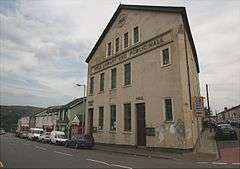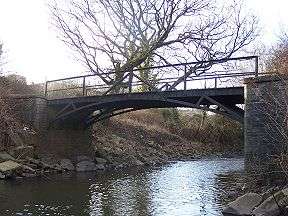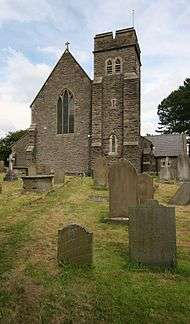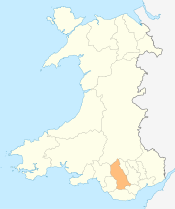Trecynon
| Trecynon | |
 Public Hall and Library, Trecynon |
|
 Trecynon |
|
| OS grid reference | SN995035 |
|---|---|
| Principal area | Rhondda Cynon Taf |
| Ceremonial county | Mid Glamorgan |
| Country | Wales |
| Sovereign state | United Kingdom |
| Post town | ABERDARE |
| Postcode district | CF44 |
| Dialling code | 01685 |
| Police | South Wales |
| Fire | South Wales |
| Ambulance | Welsh |
| EU Parliament | Wales |
| UK Parliament | Cynon Valley |
| Welsh Assembly | Cynon Valley |
|
|
Coordinates: 51°43′16″N 3°27′23″W / 51.721187°N 3.456308°W
Trecynon is a village near Aberdare situated in the Cynon Valley, in Rhondda Cynon Taf, Wales. It dates from the early nineteenth century and its developed as a result of the opening of the Aberdare Ironworks at Llwydcoed in 1800.[1]
Background and History
The settlement was originally known as Heol-y-Felin (translated as Mill Street) due its location on the road to Llwydcoed Mill.[1] This name was still in use in 1855 when Heolyfelin Chapel was established. The name Trecynon was adopted around 1860 after a competition was held at a local eisteddfod competition to decide upon a name for the village.[1]
In 1811, the Robertstown Tramway Bridge, was built over the river Cynon, linking Heolyfelin and Robertstown. It is the oldest of its kind in the world.[2]
Until 1800 there was only one house at Heol-y-Felin, next to Hen-Dy-Cwrdd Unitarian Chapel, built in 1751. As the iron industry attracted migrants to the Aberdare District there was an increased demand for housing, and, as a result Heol-y-Felin began to grow. Many of the earliest houses in were built along the main road from Aberdare to Hirwaun.[1]
By the 1860s Heol-y-Felin had become one of the main population centres in the parish of Aberdare Parish,and Harriet Street, Ebenezer Street, Alma Street, Mount Pleasant Street and Margaret Street were all built in this period.[1]
Such rapid and intensive development inevitably led to public health problems, as were revealed in 1853 when Thomas Webster Rammell prepared a report for the general Board of Health on the condition of public health in Aberdare. Heol-y-Felin was not considered the worst case in the district by any means but there wereconcerns. John Griffith, Vicar of Aberdare, reported that:
"There is not, to my knowledge, a place in Aberdare more filthy than the neighbourhood of the Royal Oak in the same quarter of the town. Mill-Street proper is in a very bad state from the ash-heaps of rubbish and filth thrown into and lying on the centre of the road."[1]
Likewise, local industrialist Rees Hopkin Rhys reported: "Many of the houses in this quarter are of a very inferior description, and these have no privy accommodation whatever. The new houses, here, as a rule, have one privy for two houses."[1]
Rammell's report led directly to the formation of the Aberdare Local Board of Health the following year. The Local Board, which later became the Aberdare Urban District Council was responsible for a range of local improvements in Aberdare, including the opening of Aberdare Park in 1869.
Population continued to grow steadily in the late nineteenth and early twentieth century, as a result of the steam coal trade.
In August 1902 the foundation stone of the Trecynon Public Hall and Library was laid by Lord Windsor and D.A. Thomas M.P. Funds for the construction of the Hall came from a variety of sources, including local coalowners. The hall was officially opened on 10 March 1903 when a grand concert was organised.[1]
The Coliseum Theatre was opened on 17 September 1938.
Industry
The Aberdare Ironworks at Llwydcoed was the main employer in the early industrial period. The Ironworks closed in 1875 and thereafter coal became the main source of employment.
Education
In 1848 the Aberdare British Schools (Ysgol-y-Comin) were built on an unenclosed area of Hirwaun Common and in 1896 the Aberdare Boy's County School was built on the Southern edge of Trecynon.
Religion
The earliest building in Trecynon was Hen Dy Cwrdd Chapel the oldest Nonconformist chapel in the Cynon Valley. Hen Dy Cwrdd Chapel was founded in 1751 and rebuilt in 1862. The chapel had two notable ministers during the nineteenth century. Thomas Evans (Tomos Glyn Cothi), minister from 1811 until 1833 was a political radical who was a pioneer in the political reform movement. His replacement John Jones, minister from 1833 until 1863 was also a radical and was one of the founders of the magazine Yr Ymofynnydd, which he used to publish his radical ideals. Unitarians cared less for their buildings than other nonconformist denominations who built increasingly grandiose edifices such as Calfaria, Aberdare. When the new building was opened in 1862, John Jones refused to hold a special service of consecration, as he considered such a service was too suggestive of 'popery'.[1]
Although the building still survives, the chapel closed in the mid 1990s due to a declining congregation. It is hoped that an alternative use will be found for the chapel building in the future. No services are held at the chapel nowadays, but the building remains as a protected Grade II listed building.[3]
St Fagan's Church is one of the oldest churches in the Aberdare district and was built in the 1854 when John Griffith was vicar of Aberdare. It was built to serve the needs of the growing Anglican congregation in the upper Cynon Valley. The church was paid for by Harriet Windsor-Clive, Baroness Windsor and, when the church burnt down in 1856, was rebuilt again at her expense.[4][5]
Each of the major nonconformist denominations established chapels at Trecynon. Ebenezer was one of the oldest Independent chapels in the locality. Heolyfelin was established in 1855 as a branch of the Baptist church at Hirwaun. Carmel was a Calvinistic Methodist chapel, as was Bryn Seion in Mill Street,
21st Century Trecynon
The most prominent local attraction and landmark is Aberdare Park, a popular public Victorian era park which was opened in 1869 on a 50-acre (200,000 m2) site.
The Aberdare College campus site of Coleg Morgannwg is situated within the northern part of the village, on Cwmdare Road.
Aberdare Boys' Grammar School was opened in Trecynon in 1896 as 'Aberdare Intermediate School'. The school relocated to Cwmdare Road in 1964 and ceased to be a grammar school in 1978 when it became the new Aberdare Boys' Comprehensive School. Today it is called Aberdare High School.
Comin Infant school and Comin Junior School are located within the village. Both school sites are physically connected.
Gallery
 Trecynon's Historic Cast Iron Bridge
Trecynon's Historic Cast Iron Bridge Apostolic Church, David Street, Trecynon
Apostolic Church, David Street, Trecynon
Notable people
- Gwyn Morgan (writer) - writer
- Mihangel Morgan - Welsh language writer and academic (born Michael Finch)
- Ieuan Rhys - Actor (born Ieuan Evans)
- Griffith Rhys Jones - was a Welsh conductor of the famous 'Côr Mawr'
See also
References
- 1 2 3 4 5 6 7 8 9 "Our Past". RCT Library Services. Retrieved 26 January 2014.
- ↑ Engineering timeline: Robertstown Tramway Bridge. Accessed 11 October 2013
- ↑ "Photos & Notes on Hen Dy Cwrdd". Aberdare Blog Gallery. Retrieved 30 November 2008.
- ↑ "Death Of The Baroness Windsor", The Cardiff and Merthyr Guardian, 13 November 1869, p.5
- ↑ John Newman (1995), The Buildings of Wales: Glamorgan, University of Wales Press, pp. 94, 133, ISBN 0-14-071056-6

